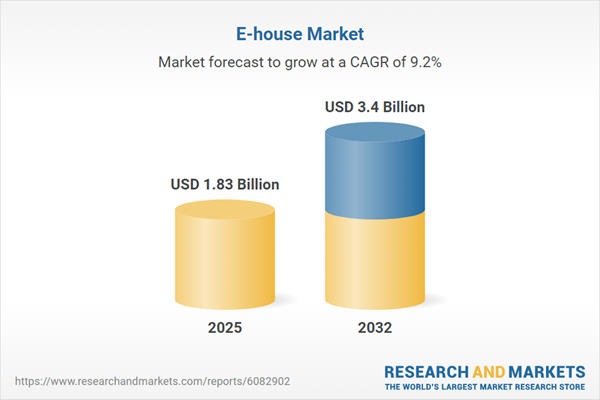Speak directly to the analyst to clarify any post sales queries you may have.
The global E-house market is undergoing a pronounced transformation, fueled by industrial modernization, resilient electrification strategies, and critical infrastructure investments. This research provides B2B leaders with a clear, actionable overview of the market’s direction and the emerging opportunities central to supplier and owner-operator success.
Market Snapshot: E-house Market Growth and Trends
The E-house market reached a value of USD 1.68 billion in 2024 and is projected to grow to USD 1.83 billion in 2025, expanding at a CAGR of 9.15% to an anticipated USD 3.40 billion by 2032.
Scope & Segmentation
This report comprehensively covers the breadth of E-house market sub-segments and applications to guide senior executives through key procurement and specification decisions.
- Type: Fixed E-House; Mobile E-House including Skid-Mounted and Trailer-Mounted variations, enabling both permanent and flexible deployment strategies.
- Construction Material: Aluminum, Concrete, Steel (Carbon Steel, Stainless Steel) – each material influences enclosure durability, cost, and regulatory compliance across industrial uses.
- Components: Control & Protection Systems, HVAC & Fire Protection, Motor Control Centers (MCC), Power Management Systems (PMS), Switchgear (Air-Insulated, Gas-Insulated), Transformers, UPS & Battery Backup, and Variable Frequency Drives (High, Medium, Low Voltage VFDs).
- Voltage Level: High Voltage (>35 kV), Medium Voltage (1-35 kV), Low Voltage (< 1 kV) – each impacting system architecture and risk mitigation strategies.
- Application: Data Center Power & Cooling, Industrial Process Automation, Mining & Metals Processing, Oil & Gas Processing, Power Generation, Power Utilities & Renewable Energy, Water & Wastewater Treatment, including integration of VFDs where required.
- Regional Coverage: Americas (North America and Latin America), Europe, Middle East & Africa, Asia-Pacific – with tailored supplier ecosystems and regulatory focus in each locale.
Featured Companies
- ABB Ltd., Siemens AG, Aktif Group, BMarko Structures LLC., CR Technology Systems, Eaton Corporation plc, HD Hyundai Electric Co., Ltd., Hitachi Energy Ltd, INESING SRL, INGETEAM S.A.
- Innomotics GmbH, KASA ANLAGEN INDIA PRIVATE LIMITED, Keltour Controls Inc., Kontrolmatik, LS Electric Co., Ltd., Macain Energy Services, Matelec Group, Powell Industries Inc., Quad Plus, Sabre Industries, Inc., Schneider Electric SE.
- Swartz Engineering, TGOOD Global Ltd., Toshiba Mitsubishi-Electric Industrial Systems Corporation, Vanguard Power Ltd., WEG S.A.
Key Takeaways for Senior Decision-Makers
- E-houses are critical enablers of resilient electrification, digital integration, and streamlined infrastructure delivery, offering standardized architectures that minimize deployment risk.
- Modular design and controlled fabrication enhance project flexibility, reduce onsite construction requirements, and support faster commissioning for both industrial and mission-critical users.
- New digital monitoring and remote diagnostics tools are driving condition-based maintenance, helping managers pre-empt performance issues and optimize asset utilization.
- Regional supply chain considerations, such as local fabrication, compliance with region-specific codes, and rapid-response service networks, are shaping procurement and deployment strategies.
- Strategic supplier partnerships, particularly among integrators, OEMs, and service providers, are becoming the norm to deliver turnkey solutions and continuous lifecycle support.
- Preference for modular, upgradeable power enclosures is rising amid regulatory complexity, emphasizing the need for adaptable configurations and robust compliance documentation.
Tariff Impact on Sourcing and Procurement Resilience
Recent tariff measures and evolving trade policies have significantly affected sourcing and supplier decisions in E-house market supply chains. Cost pressures are reinforcing a shift toward local content, domestic fabrication, and greater inventory buffers. Engineering adaptations, supplier consolidation, and contract mechanisms are now routinely employed to enhance resilience and mitigate exposure to tariff-driven risks.
Methodology & Data Sources
Analysis for this report is rooted in direct engagement with manufacturers, integrators, engineers, and operations managers. Qualitative interviews, complemented by a thorough review of technical standards and regulatory documents, ensure the validity and real-world relevance of all insights presented.
Why This Report Matters
- Enables procurement, engineering, and operations leaders to benchmark supplier strategies and technology adoption across diverse segments.
- Delivers practical guidance for aligning project, sourcing, and regulatory approaches in fast-evolving regional and global E-house markets.
- Supports strategic planning with actionable intelligence on modular integration, supply chain resilience, and aftermarket service differentiation.
Conclusion
Senior leaders relying on this analysis can strengthen project execution, minimize lifecycle risk, and optimize both operational and commercial value from E-house investments. The path forward centers on adaptive sourcing, digital maturity, and regional alignment for sustained success.
Table of Contents
3. Executive Summary
4. Market Overview
7. Cumulative Impact of Artificial Intelligence 2025
Companies Mentioned
The companies profiled in this E-house market report include:- ABB Ltd.
- Siemens AG
- Aktif Group
- BMarko Structures LLC.
- CR Technology Systems
- Eaton Corporation plc
- HD Hyundai Electric Co., Ltd.
- Hitachi Energy Ltd
- INESING SRL
- INGETEAM, S.A.
- Innomotics GmbH
- KASA ANLAGEN INDIA PRIVATE LIMITED
- Keltour Controls Inc.
- Kontrolmatik
- LS Electric Co., Ltd.
- Macain Energy Services
- Matelec Group
- Powell Industries Inc.
- Quad Plus
- Sabre Industries, Inc.
- Schneider Electric SE
- Swartz Engineering
- TGOOD Global Ltd.
- Toshiba Mitsubishi-Electric Industrial Systems Corporation
- Vanguard Power Ltd.
- WEG S.A.
Table Information
| Report Attribute | Details |
|---|---|
| No. of Pages | 185 |
| Published | November 2025 |
| Forecast Period | 2025 - 2032 |
| Estimated Market Value ( USD | $ 1.83 Billion |
| Forecasted Market Value ( USD | $ 3.4 Billion |
| Compound Annual Growth Rate | 9.1% |
| Regions Covered | Global |
| No. of Companies Mentioned | 27 |









